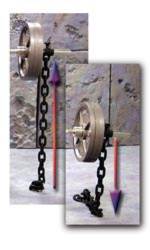BIGGER FASTER STRONGER LIFTING CHAINSLifting chains are becoming more and more popular. Do they have merit? Will they give an athlete an edge? Will an athlete get stronger at a faster rate? I answer “Yes” to all these questions and give<By Dr. Greg Shepard Published: Summer 2002 As you start an upward movement on a bench or squat without chains, the weight will get easier and easier to lift becuase your strength increases as your arms or legs straighten. Lifting chains create variable resistance. Variable resistance gradually adds weight as the bar moves upward. This makes the entire body work harder. Many studies have shown effective increases in strength with this method. The body seems to want to adapt to the heavier weight and thus, when you go for a new max, you have a greater chance of being successful. One of the reasons for doing the towel bench and the box squat is to get used to heavier weight. This principle alone gives a training advantage. The principle of variable resistance has been around for decades. My first acquaintance with this training method involved machines. Even though the principle was good, machine work for an athlete had a number of negatives. As a result, free weights have always ruled supreme with most strength coaches and athletes. Part of my doctoral dissertation involved a variable resistance machine. So, when the idea of lifting chains came on the scene, I was interested. The reason I am enthusiastic about lifting chains is that you can do variable resistance with free weights. Plus, it’s so doggone simple. How Lifting Chains Fit into the BFS System Lifting chains can be used as bench and/or squat variations. Variation is the key to success in breaking records and not getting stuck on those dreaded plateaus. Therefore, instead of towel benches, you could do chain benches. Instead of box squats or front squats, you could do chain squats. You could also add the chains to the towel bench and the box squat. You could use the chains just on the regular bench and the parallel squat. There are a lot of possible variations. I think it could be a lot of fun and add some real excitement to any lifting program. Expect to break more records than ever. The lifting chains can also be used for auxiliary lifts like the incline press. The BFS lifting chains can be used at all levels, from junior high to the most advanced athletes. By having three different chains in weight, different combinations can be used to create even more challenges and variations. It’s hard not to get pumped up about all the possibilities and the potential edge you can gain. Comparing Chains with Other Ideas Surgical tubing is an option to get the same effect. On the plus side, surgical tubing costs less than chains. On the downside, surgical tubing creates less stability during the lift and you cannot measure what you are doing. To me, that is a huge downside. I want to measure everything I do. Weight hook systems add weight coming down (eccentric) but do not do it gradually like the chain system. The weight hook systems I have seen do not do anything on the way up (concentric). To me, that is also a negative. Specifics of the BFS Lifting Chains We provide three different chains: A Varsity Chain that adds about 25 pounds to a squat and 15 pounds to a bench press, an All-State Chain that adds about 40 pounds to a squat and 25 pounds to a bench press, and our All-American Chain that adds about 55 pounds to a squat and 37 pounds to a bench press. Normally, adding about ten percent at the easiest point is most beneficial. That is the reason for the different-size chains. For example, I would not want to put on 37 extra pounds for an athlete who only bench presses 150 pounds. It would not work as intended. I would not want to add an extra 55 pounds for an athlete who parallel squats 215 pounds. It would prove to be too difficult. However, for someone who parallel squats or box squats 500-plus pounds, the 55-pound All-American chain would be a great but still realistic challenge that would produce the intended results. The Varsity Chain: For athletes who bench less than 200 pounds and squat with less than 300 pounds. The All-State Chain: For athletes who bench between 200 and 300 pounds, and squat between 300 and 400 pounds. The All-American Chain: For athletes who bench over 300 pounds and squat over 400 pounds. Versatility: Two chains will fit easily on each side of the bar. Therefore, different combinations can be created. By putting the All-State and All-American Chains on together, you can add 62 pounds on the bench and 95 pounds on the squat. Recording: I recommend recording what is on the bar plus the code of whatever chain you are using. Use “VC” for the Varsity Chain, “AS” for the All-State Chain and “AA” for the All-American Chain. For example, an athlete who does 185 pounds plus the Varsity Chain would record 185 VC. The BFS Lifting Chains will make a difference. Our easy-on/off collar makes their use extremely effective and safe. Have fun with them and get new maxes quicker than ever before! |
 |
|
Lifting chains can be used as bench and/or squat variations. Variation isn the key to success in breaking records and not detting stuck on those dreaded plateaus. BFS carries three chain options:All-American, All-State and Varsity. |
 |
|
How chains work: As the bar moves upward the weight of the chain is taken off the floor and added to the bar's weight. The more achain the comes off the ground the heaveir the weight becomes. |